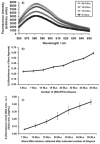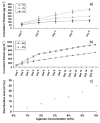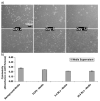Time Controlled Protein Release from Layer-by-Layer Assembled Multilayer Functionalized Agarose Hydrogels
- PMID: 20200599
- PMCID: PMC2830720
- DOI: 10.1002/adfm.200901172
Time Controlled Protein Release from Layer-by-Layer Assembled Multilayer Functionalized Agarose Hydrogels
Abstract
Axons of the adult central nervous system exhibit an extremely limited ability to regenerate after spinal cord injury. Experimentally generated patterns of axon growth are typically disorganized and randomly oriented. Support of linear axonal growth into spinal cord lesion sites has been demonstrated using arrays of uniaxial channels, templated with agarose hydrogel, and containing genetically engineered cells that secrete brain-derived neurotrophic factor (BDNF). However, immobilizing neurotrophic factors secreting cells within a scaffold is relatively cumbersome, and alternative strategies are needed to provide sustained release of BDNF from templated agarose scaffolds. Existing methods of loading the drug or protein into hydrogels cannot provide sustained release from templated agarose hydrogels. Alternatively, here it is shown that pH-responsive H-bonded poly(ethylene glycol)(PEG)/poly(acrylic acid)(PAA)/protein hybrid layer-by-layer (LbL) thin films, when prepared over agarose, provided sustained release of protein under physiological conditions for more than four weeks. Lysozyme, a protein similar in size and isoelectric point to BDNF, is released from the multilayers on the agarose and is biologically active during the earlier time points, with decreasing activity at later time points. This is the first demonstration of month-long sustained protein release from an agarose hydrogel, whereby the drug/protein is loaded separately from the agarose hydrogel fabrication process.
Figures









Similar articles
-
Templated agarose scaffolds for the support of motor axon regeneration into sites of complete spinal cord transection.Biomaterials. 2013 Feb;34(5):1529-36. doi: 10.1016/j.biomaterials.2012.10.070. Epub 2012 Nov 23. Biomaterials. 2013. PMID: 23182350 Free PMC article.
-
Regeneration of long-tract axons through sites of spinal cord injury using templated agarose scaffolds.Biomaterials. 2010 Sep;31(26):6719-29. doi: 10.1016/j.biomaterials.2010.04.035. Epub 2010 Jun 17. Biomaterials. 2010. PMID: 20619785
-
Templated agarose scaffolds support linear axonal regeneration.Tissue Eng. 2006 Oct;12(10):2777-87. doi: 10.1089/ten.2006.12.2777. Tissue Eng. 2006. PMID: 17518647
-
Cell-seeded alginate hydrogel scaffolds promote directed linear axonal regeneration in the injured rat spinal cord.Acta Biomater. 2015 Nov;27:140-150. doi: 10.1016/j.actbio.2015.09.001. Epub 2015 Sep 5. Acta Biomater. 2015. PMID: 26348141
-
Extracellular vesicle-loaded hydrogels for tissue repair and regeneration.Mater Today Bio. 2022 Dec 21;18:100522. doi: 10.1016/j.mtbio.2022.100522. eCollection 2023 Feb. Mater Today Bio. 2022. PMID: 36593913 Free PMC article. Review.
Cited by
-
Augmenting protein release from layer-by-layer functionalized agarose hydrogels.Carbohydr Polym. 2014 Mar 15;103:377-84. doi: 10.1016/j.carbpol.2013.12.069. Epub 2013 Dec 28. Carbohydr Polym. 2014. PMID: 24528743 Free PMC article.
-
Recent Progress on Polysaccharide-Based Hydrogels for Controlled Delivery of Therapeutic Biomolecules.ACS Biomater Sci Eng. 2021 Sep 13;7(9):4102-4127. doi: 10.1021/acsbiomaterials.0c01784. Epub 2021 Jun 17. ACS Biomater Sci Eng. 2021. PMID: 34137581 Free PMC article. Review.
-
Cell adhesive behavior on thin polyelectrolyte multilayers: cells attempt to achieve homeostasis of its adhesion energy.Langmuir. 2010 Aug 3;26(15):12794-802. doi: 10.1021/la101689z. Langmuir. 2010. PMID: 20604583 Free PMC article.
-
New molecular therapies for the treatment of hearing loss.Pharmacol Ther. 2019 Aug;200:190-209. doi: 10.1016/j.pharmthera.2019.05.003. Epub 2019 May 8. Pharmacol Ther. 2019. PMID: 31075354 Free PMC article. Review.
-
Templated agarose scaffolds for the support of motor axon regeneration into sites of complete spinal cord transection.Biomaterials. 2013 Feb;34(5):1529-36. doi: 10.1016/j.biomaterials.2012.10.070. Epub 2012 Nov 23. Biomaterials. 2013. PMID: 23182350 Free PMC article.
References
-
- Stokols S, Sakamoto J, Breckon C, Holt T, Weiss J, Tuszynski MH. Tissue Eng. 2006;12:2777. - PubMed
-
- Tuszynski MH, Gabriel K, Gage FH, Suhr S, Meyer S, Rosetti A. Exp Neurol. 1996;137:157. - PubMed
-
- Blesch A, Tuszynski MH. J Comp Neurol. 2003;467:403. - PubMed
-
- Bradbury EJ, Khemani S, King VR, Priestley JV, McMahon SB. Eur J Neurosci. 1999;11:3873. - PubMed
-
- Menei P, Montero-Menei C, Whittemore SR, Bunge RP, Bunge MB. Eur J Neurosci. 1998;10:607. - PubMed
Grants and funding
LinkOut - more resources
Full Text Sources
Other Literature Sources
